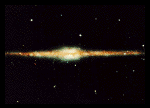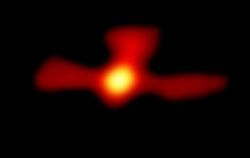

An image of our galaxy, the Milky Way
An "antimatter cloud" recently found at the center of our Milky Way Galaxy
The Isotope Matter-Antimatter Experiment (IMAX)
Antimatter in Cosmology
Of course, acceleration (and deceleration) of particles are not the only way to study antimatter. Antimatter could exist somewhere in the outer space. Dirac himself was the first to consider the existence of antimatter in an astronomical scale. But it was only after the confirmation of his theory, with the discovery of the positron, antiproton and antineutron, that real speculation began on the possible existence of antiplanets, antistars, antigalaxies and even an antiuniverse.
In the late 1950s, the amount of antimatter in our galaxy was calculated to be less then one part in a hundred million. If there were an isolated system of antimatter in the universe, free from interaction with ordinary matter, no earthbound observation could distinguish its true content.
So, even if nothing was visible, the possibility of extragalactic antimatter was wide open. And in the following years, motivated by basic symmetry principles, it was belived that the universe must consist of both matter and antimatter in equal amounts.
However, it is nowadays strongly believed that there is merely one universe, composed primarily of matter. One could speculate, though, that if any natural antimatter, let say antinuclei from an antimatter galaxy, would try to reach us, it would annihilate with nuclei in the earth's atmosphere, and never be detected.
Over the past twenty years, scientists have tried to take their instruments as high as possible in the atmosphere (originally with balloons, later with satellites) on the attempt to overcome this annihilation problem, but such an effort is costly and difficult. Nowadays, experiments are planned to be implemented on satellites. In 1998, for instance, a high-energy particle detector, the Alpha Magnetic Spectrometer (AMS), was flown on the Space Shuttle Discovery for a ten-day mission, and it is now being redesigned and upgraded to be installed on the International Space Station for a few years. Orbiting around the Earth above the atmosphere, one of its goals is to measure the fluxes of charged antiparticles and antinuclei to search for any form of cosmic antimatter
.
|
(Antimatter
in Cosmology - page 1 of 3)
| Next > |



